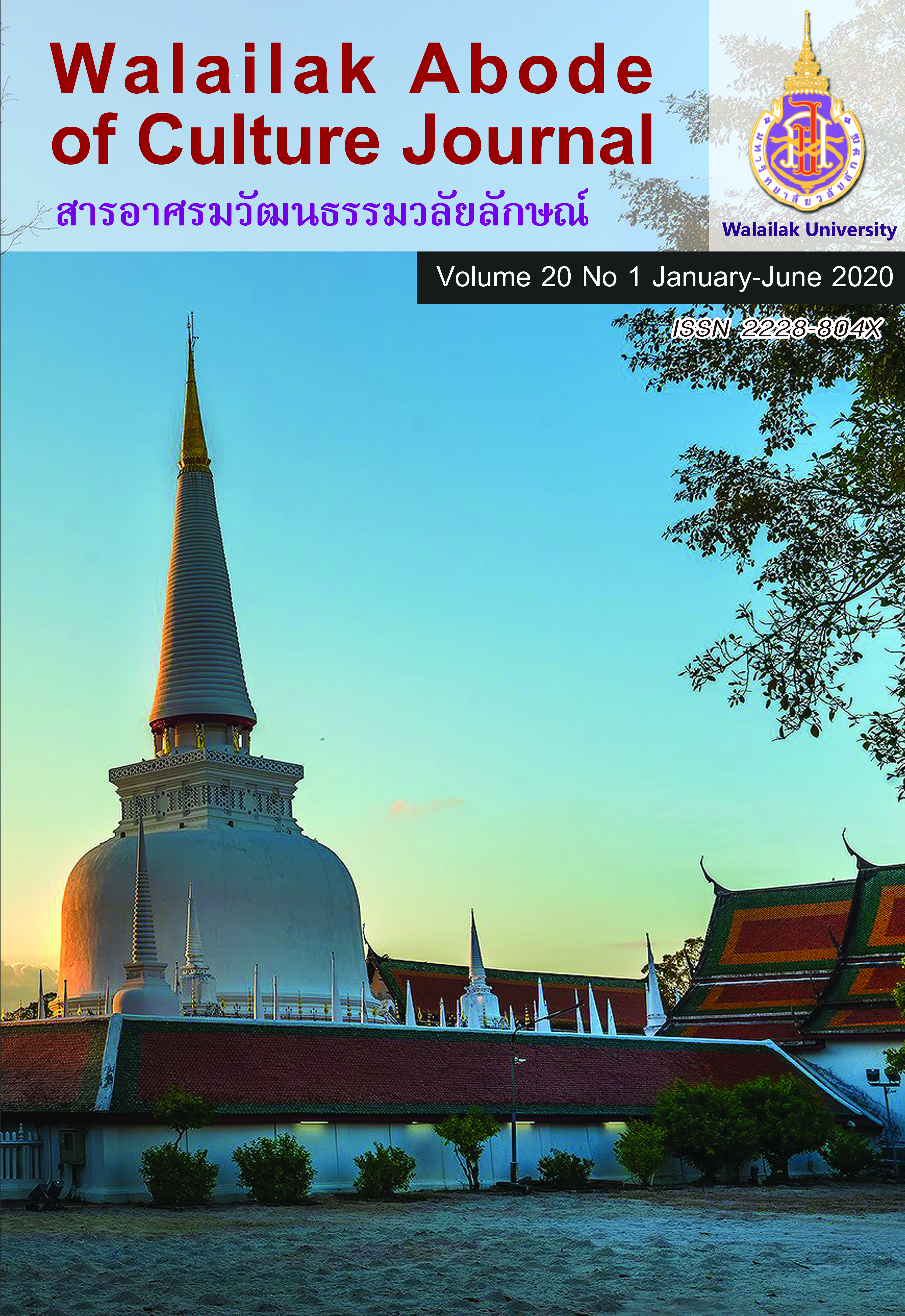Some Observations on the Enshrinement of the Tooth Relic at Crystal Sand Beach
Main Article Content
Abstract
Many legends of southern Thailand claim that the Buddha's Tooth Relic had been enshrined at Had Sai Kaeo or Nakhon Si Thammarat in modern times. But many literatures of Sri Lanka assure that the Tooth Relic has been brought to Sri Lanka since the 4th century. Currently, it is enshrined at the Tooth Relic Temple in Kandy. On this point, many Thai scholars showed their views both negative and positive. Mostly their belief based on evidences from Thai literatures. To analysis this point by searching primary sources from other countries could make many points of view. Also, it could actually answer whether the Tooth Relic had been enshrined in Nakhon Si Thammarat? In this academic topic, 3 observations have been analyzed; namely 1) the Tooth Relic had been enshrined at Had Sai Kaeo because of the influence of the Buddhist missionary, 2) the Tooth Relic had been enshrined at Had Sai Kaeo because of the influence of Abhayagiri School of Sri Lanka and 3) the Tooth Relic had been enshrined at Had Sai Kaeo because of the influence of Myanmar. These three issues should be able to answer the story of the Tooth Relic whether it was enshrined at Had Sai Kaeo, Nakhon Si Thammarat? If not true, why the legend of southern Thailand referred such story? Or, is it just a link between occurrences for political legitimacy?
Article Details
© 2018 by Asian Journal of Arts and Culture, Walailak University. All rights reserved.
References
Chandawimala, R. (2007). The Impact of the Abhayagiri Practices on the Development of Theravada Buddhism in Sri Lanka. (Ph.d. Dissertation, University of Hong Kong).
Chou Yi-Ling. (1944). Tantrism in China. Cambridge, England: Harvard-Yenching Institute.
Damrong Rajanubhab. (1974). Traveling Burma. Bangkok, Thailand: Klangvidhya.
De Casparis, J. G. (1961). New Evidence on Cultural Relations between Java and Ceylon in Ancient Times. Artibus Asiae, 24(3/4), 241-243, 245-248.
Degroot, V. (2006). The Archaological Remains of Ratu Boko: From Sri Lankan Buddhism to Hindunism. Indonesia and Malay World, 34(98), 55-74.
Dhammakitti Thera, Phra. (1874). The Dathavansa. Translated by Mutu Coomara Swamy. London, England: Trubner & Co.
Dhammavisuddhi, Y. (1970). The Buddhist Sangha in Ceylon (circa 1200-1400 A.D.). (Ph.d. Dissertation, University of London).
Dohanian, D.K. (1977). The Mahayana Buddhist Sculpture of Ceylon. New York, NY: Garland Publishing.
Fa-Hien. (1998). A Record of Buddhist Kingdoms. Translated and Annotated by James Legge. Delhi, India: Munshiram Manoharlal Publishers.
Fine Arts Department. (1986). Thai Inscription Vol. I. Bangkok, Thailand: Phappim Publication.
Fine Arts Department. (1986). Thai Inscription Vol. II. Bangkok, Thailand: Phappim Publication.
Geiger, W. (Translator). (1992). Culavamsa, Part, I. New Delhi, India: Asian Educational Services.
Geiger, W. (Translator). (1992). Culavamsa, Part, II. New Delhi, India: Asian Educational Services.
Goonatilake, S.A.H. (1974).The Impact of Some Mahayana Concepts on Sinhalese Buddhism. (Ph.d. Dissertation, University of London).
Gunawardhana, R.A.L.H. (1979). Robe and Plough. Arizona, USA: The University of Arizona Press.
Herath, D. (1994). The Tooth Relic and the Crown. Colombo, Sri Lanka: Gunaratne Offset Ltd.
Hiuen Tsiang. (1906). Buddhist Records of the Western World, vol.II. Translated by Samauel Beal. London, England: Kegan Paul.
Jayabahu Thera, Phra. (1908). The Nikaya Sanghahawa. Translated by C.W. Fernando. Colombo, Sri Lanka: H.C. Cottle, Government Printer, Ceylon.
Lahiri, L. (1974). Ceylon and China: The Account of Ceylon in the Dynastic History of the Tang Period. Paper presented at the Proceedings of the Indian History Congress. Retrieved from https://www.jstor.org/stable/44138805?seq=1.
Mahanama Thera, Phra. (2000). The Mahavamsa. Translated by Wilhelm Geiger. New Delhi, India: Asian Educational Services.
Nastiti, T. S. (2011, July). Chapter 14 Early Writings in Indonesia. The International Conference on Bujang Valley and Early Civilisations in Southeast Asia, Department of National Heritage, Ministry of Information, Communications and Culture, Malaysia.
O’Connor, S.J. (1971). Hindu Gods of Prninsular Siam. Ascona, Switzerland: Artibus Asiae Publishers.
Oldenberg, H. (Translator). (2001). The Dipavamsa. New Delhi, India: Asian Educational Services.
Paranavitana, S. (1960). History of Ceylon Vol.ii. Colombo, Sri Lanka: University of Ceylon.
Paranavitana, S. (1966). Ceylon and Malaysia. Colombo, Sri Lanka: Lake House Investment.
Pe Maung Tin and G.H. Luce (Translator). (1960). The Glass Palace Chronicle of the Kings of Burma. Rangoon, Myanmar: Rangoon University Press.
Rahula, W. (1993). History of Buddhism in Ceylon. Dehiwala, Sri Lanka: The Buddhist Cultural Centre.
Seneveratne, J. M. (1917). Chino-Sinhalese Relations in the Early and Middle Ages, JCBRAS, vol. xxiv, no. 68, part. i. Colombo, Sri Lanka: the Colombo Apothecaries Co., Ltd., Printers.
Srisuchat, A. (2014). Srivijaya in Suvannadvipa. Bangkok, Thailand: Rungsilkarnpim Company.
Sundberg, J.R. (2004). The Wilderness monks of the Abhayagirivihara and the origins of Sino-Javanese esoteric Buddhism, Journal of Bijdragen tot de Taal-, Land-en Volkenkunde, 160(1), 95-123
Taw Sein Ko (Translator). (1892). The Kalyani Inscriptions. Rangoon, Myanmar: Government Printing.
The Chronicle of Stupa of Nakhon Si Thammarat. (1982). Bangkok, Thailand: Phosonpipattanakorn Publication.
Vogel, J. P. (1936). Buddhist Art in India, Ceylon and Java. Oxford, England: At the Clarendon Press.
Wickremasinghe, D. M. de Zilva. (1985). Epigraphia Zeylanica being Lithic and other Inscriptions of Ceylon, vol. II. London, England: Oxford University Press.
Wickramasinhe, S. (1956) The Kalinga Period of Ceylon History (1186 A.D.-1235 A.D.). (Ph.d. Dissertation, University of Ceylon).


